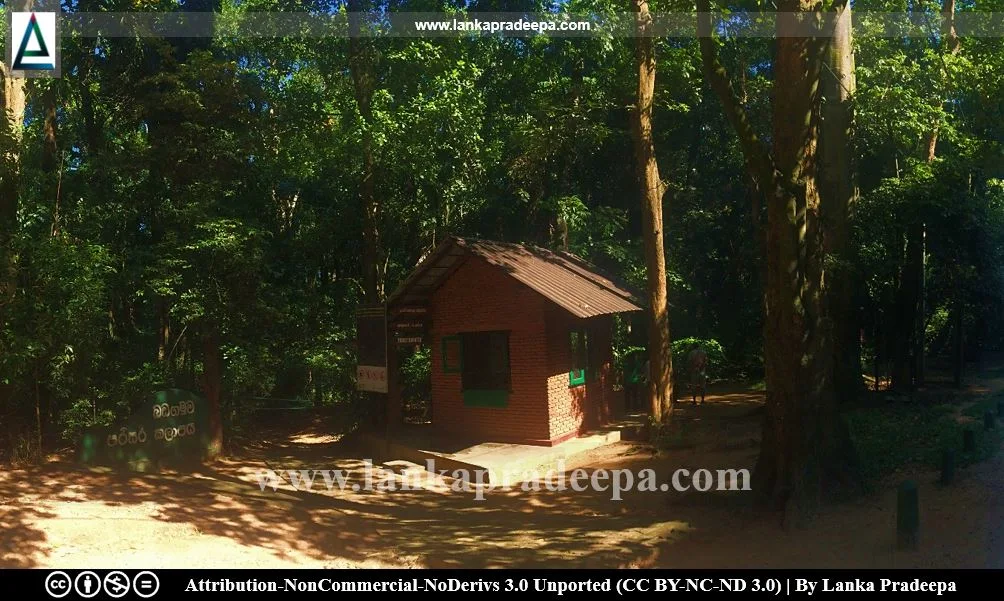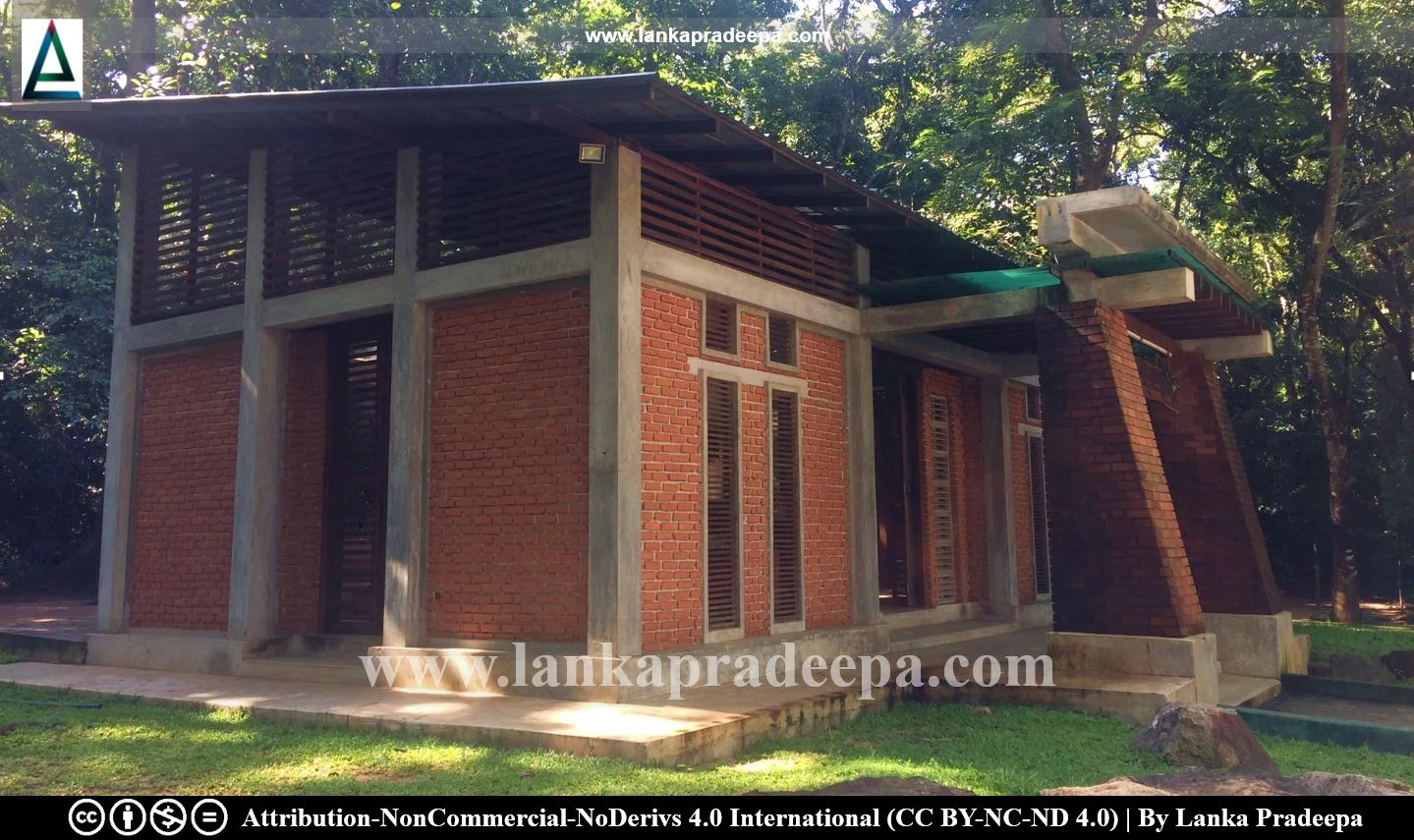
|
Badagamuwa Conservation Forest |
Badagamuwa Conservation Forest (Sinhala: බඩගමුව සංරක්ෂිත වනාන්තරය; Tamil: படகமுவ பாதுகாப்பு காடு) is a secondary forest in Kurunegala District, Sri Lanka. It is located on the wayside of Kurunegala-Dambulla road (A6 road) approximately 4 km distance from the Kurunegala town.
History
Due to human interventions, the natural forest that existed at Badagamuwa started to degrade during the 17th century. However, the site was declared a "Conservation Forest" by the government on 1 June 1894, under gazette no. 5290 and a reforestation process was initiated in 1895, by the English Captain A. M. Walker. The A6 road that runs across the Badagamuwa forest today is said to be there at the time as a small cart-sized track.
In 1925, several valuable trees such as Jack, Mahogani, Teak, Nedun, Burutha, Ethdemata, Milla, etc., were planted in this site by the Department of Forest. Before that process, the department had collected the wood harvest from the forest and given the plotted lands to villagers to cultivate several crops such as Pumpkin, Plantain, Papaya, etc. After that, the cultivated lands were burnt and developed again as a forest area. In 1968, several plants such as Jack, and Mahogani were re-planted in the forest.
In the beginning, several selected trees were cut down from Badagamuwa forest as the wood harvest but it ceased when the government decided to protect it as a conservation forest. On 13 September 2007, the forest was upgraded as a Conservation Forest under the gazette (extraordinary) no. 1514/22. Presently, the Badagamuwa Conservation Forest covers 217 hectares and 50 hectares of which have been identified as a "Man and Biosphere Reserve".
The Forest
Situated in the Intermediate Zone of Sri Lanka, the Badagamuwa forest has an annual rainfall of 1750-2500 mm. It is a secondary forest resulting from forest regeneration followed by the abandonment of the plantation for several decades. Presently, the forest is home to more than 130 plant species and 300 animal species.
The canopy of the forest is mainly dominated by plantation species such as Jack (Artocarpus heterophyllus) and Mahogani (Swietenia macrophylla) and the lower strata have been regenerated by typical forest species. A vegetation survey conducted by the Department of Forest has recorded more than 30 main species in the Badagamuwa forest including Jack, Milla, Pihimbia, Budediyala, Diyakirala, Heenambilla, Walwaraka, etc. Native species such as Wild Coffee, Etamba, Malaboda, and Nedun have been also recorded by them. Besides the vegetation survey, a fauna survey conducted by the "Young Zoologists' Association" revealed many reptiles, birds, butterflies, amphibians, and mammal species that are native to Sri Lanka.
Thuruviyana Habitat Improvement Project
Forest openings have been created in several places in the forest due to the dense cover of liana species spreading over the canopy such as Hinguru-wel (Acacia caesia) and Kanduru-ketiya-wel (Combretum albidum). Under the Thuruviyana habitat improvement project, these lianas are removed systematically to restore the forest openings.
 .
.
Related Posts
Read Also
References
Primary Sources
1) Information from the "Badagamuwa Environmental Information Center"
Location Map
Dynamic Google Map
බඩගමුව සංරක්ෂිත වනාන්තරය
බඩගමුව සංරක්ෂිත වනාන්තරය ශ්රී ලංකාවේ කුරුණෑගල දිස්ත්රික්කයේ පිහිටි ද්විතීක වනාන්තරයකි. කුරුණෑගල-දඹුල්ල මාර්ගයෙහි (A6), කුරුණෑගල නගරයේ සිට කි. මි. 4ක් පමණ දුරින් වූ මග දෙපස මෙම වනාන්තරය පිහිටා ඇත.
ඉතිහාසය
මානව අතපෙවීම් හේතුකොටගෙන බඩගමුවෙහි තිබූ ස්වභාවික වනාන්තරය හායනය වීම 17වන සියවස වන විට ආරම්භ විය. කෙසේනමුදු, 1894 ජූනි 1වන දින ගැසට් අංක 5290 යටතේ රජය විසින් මෙම ප්රදේශය සංරක්ෂිත වනාන්තරයක් වශයෙන් ප්රකාශයට පත්කල අතර 1895දී ඉංග්රීසි ජාතික ඒ.එම්. වොල්කර් විසින් යලි වන වගා කිරීමේ ක්රියාවලිය ආරම්භ කරන ලදී. වර්තමානයේ බඩගමුව හරහා දිවෙන A6 මාර්ගය එකල කුඩා කරත්ත පාරක් වූ බව සඳහන්ය.
1925දී වන දෙපාර්තමේන්තුව විසින් මෙහි කොස්, මහෝගනී, තේක්ක, නැදුන්, බුරුත, ඇත්දෙමට, හා මිල්ල වැනි වටිනා ශාක රෝපණය කරන ලදී. මෙම ක්රියාවලියට පෙරාතුව, දෙපාර්තමේන්තුව විසින් වනයෙහි වූ වටිනා දැව අස්වැන්න එකතු කර ගනිමින් එහි වූ භූමිය කොටස් වශයෙන් වට්ටක්කා, කෙසෙල්, ගස්ලබු වැනි භෝග වගාකිරීම පිණිස ගම්වැසියන්ට ලබා දී තිබුණි. මින් අනතුරුව වගා කරන ලද භූමිය පුළුස්සා නැවත වතාවක් වනාන්තර කලාපයක් ලෙස සංවර්ධනය කෙරුණි. 1968දී කොස්, මහෝගනී වැනි සමහර ශාක වර්ග වනාන්තරයෙහි යළි රෝපණය කරන ලදී.
ආරම්භක සමයේදී බඩගමුව වනාන්තරයෙහි වූ සමහරක් සළකුණු කරන ලද ශාක දැව අස්වැන්නක් උදෙසා කපා දැමුණද, එය සංරක්ෂිත වනාන්තරයක් වශයෙන් ආරක්ෂා කිරීමට රජය තීරණය කිරීමත් සමග ගස් කැපීමේ ක්රියාවලිය නවතා දැමුණි. 2007 සැප්තැම්බර් 13වන දින අංක 1514/22 යන අතිවිශේෂ ගැසට් නිවේදනය මගින් මෙම භූමිය සංරක්ෂණ වනාන්තරයක් වශයෙන් උසස් කෙරුණු අතර වත්මන් භූමිය හෙක්ට්යාර 217කින් පමණ සමන්විත වේ. ඉන් හෙක්ට්යාර 50ක ප්රමාණයක් "මිනිසා සහ ජෙෙව ගෝලය" යන පරිසර කලාපයක් ලෙස නම්කර ඇත.
වනාන්තරය
පුනර්ජනිත වනාන්තරයක් භෝග වගාව සඳහා දශක කිහිපයක් අත්හැර දැමීමෙන් අනතුරුව නැවතත් වන වගා කිරීම හේතුවෙන් බඩගමුව යනු ද්විතීක වනාන්තරයක් වේ. ශ්රී ලංකාවේ අතරමැදි කලාපයෙහි පිහිටා ඇති එයට 1750-2500 මි.මී. පමණ ප්රමාණයක වාර්ෂික වර්ෂාපතනයක් හිමිය. වර්තමානයේදී මෙම වනාන්තරය ශාක විශේෂ 130ක් හා සත්ව විශේෂ 300කට වඩා වැඩි ප්රමාණයකට නිවහනක් ලෙස ක්රියාකරයි.
වනාන්තරයෙහි ඉහළ තුරුවියන කොස්, මහෝගනී වැනි ශාක විසින් අත්පත් කොටගෙන තිබෙන අතර පහළ තුරුවියන අනෙකුත් දර්ශීය වන ශාක වලින් සමන්විත වේ. වන සංරක්ෂණ දෙපාර්තමේන්තුව විසින් සිදුකරන ලද ශාක සමීක්ෂණයකදී කොස්, මිල්ල, පිහිඹියා, දිය කිරල, හීන් ඇඹිල්ල, වල් වරකා වැනි ශාක 30කට වැඩි ප්රමාණයක් ප්රමුඛ ශාක ලෙස වාර්තාගත කෙරුණි. එසේම ඔවුන් විසින් වල් කෝපි, ඇටඹ, මලබොඩ හා නැදුන් වැනි දේශීය විශේෂද වාර්තා කරන ලදී. මීට අමතරව "තරුණ සත්වවේදීන්ගේ සංගමය" විසින් සිදුකරන ලද සමීක්ෂණයකදී ශ්රී ලංකාවට දේශීය උරගයින්, පක්ෂීන්, සමනළුන්, උභය ජීවින්, හා ක්ෂීරපායින් විශාල ප්රමාණයක් අනාවරණය කෙරුණි.
තුරුවියන නගා සිටුවීමේ ව්යාපෘතිය
හිඟුරු වැල්, කදුරුකැටිය වැල් වැනි කාශ්ඨාරෝහක ශාක විශේෂ අධි ඝනත්වයෙන් යුතුව පැතිරී යාම හේතුවෙන් වනාන්තරයේ සමහරක් කලාප වල ඉහළ තුරුවියනෙහි සිදුරු ගොඩනැගී තිබෙන අතර තුරුවියන නගා සිටුවීමේ ව්යාපෘතිය යටතේ එම කාශ්ඨාරෝහක ශාක විශේෂ ක්රමවත් පරිදි ඉවත් කරමින් තුරුවියන යලි ප්රකෘතිමත් කිරීම සිදුකරනු ලබයි.

